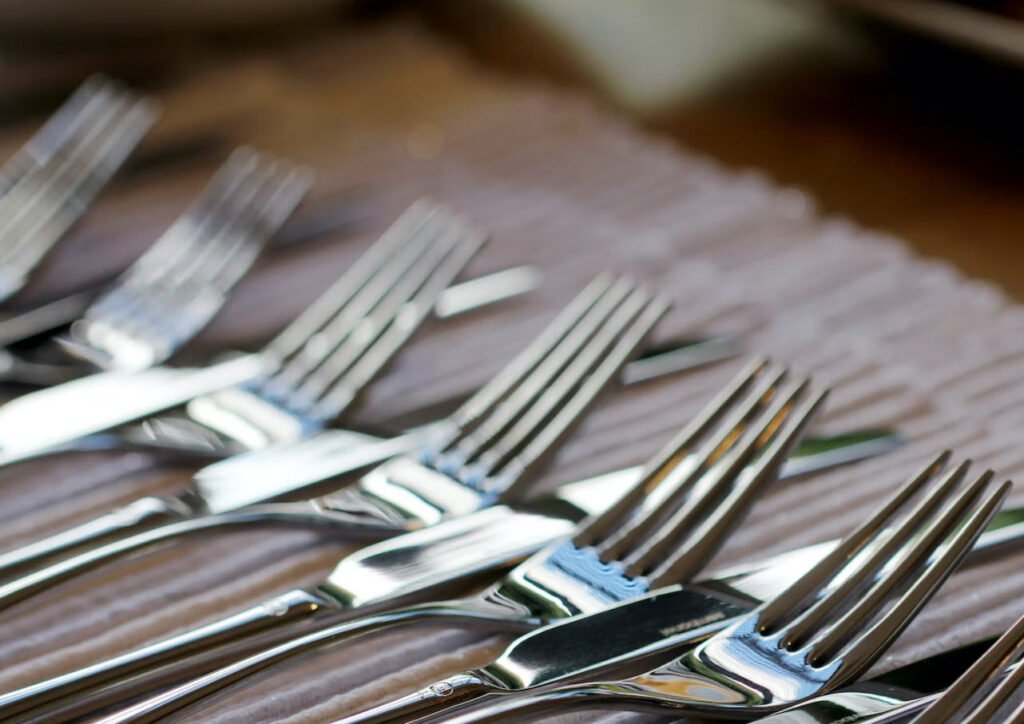
A fork is a utensil used for eating or serving food. It typically consists of three or four tines, or prongs, attached to a handle. Forks can be made from a variety of materials, including metal, plastic, and wood.
They come in a range of sizes and shapes, from small dessert forks to large serving forks. Forks are commonly used for eating foods such as pasta, meat, and vegetables, and can also be used for serving foods such as salad or fruit.
There are 13 types of the fork are as given below:
- Oyster Fork
- Fruit Fork
- Cheese Fork
- Pastry Fork
- Spaghetti Fork
- Crab Fork
- Carving Fork
- Table Fork
- Fish Fork
- Salad Fork
- Dessert Fork
- Cocktail Fork
- Snail Fork
1) Oyster Fork
An oyster fork is a small, narrow fork with three short tines and a pointed end. It is designed specifically for eating oysters, and is often used in fine dining settings. The pointed end of the fork is used to remove the oyster from its shell, while the tines are used to hold and maneuver the oyster while eating.
2) Fruit Fork
A fruit fork is a small, typically decorative fork that is designed specifically for eating fruits. It is usually smaller than a standard dinner fork and may have three or four tines. Fruit forks are often used for eating small, bite-sized fruits such as berries, grapes, and cherries, as well as for serving fruit platters. They may be made from a variety of materials including metal, plastic, or wood.
3) Cheese Fork
A cheese fork is a small fork with two long tines, designed specifically for serving and cutting cheese. It is usually smaller than a standard dinner fork, and may have a curved or pointed end. The tines of the cheese fork are designed to be sharp enough to cut into cheese, while also being long enough to hold a piece of cheese in place for serving. Cheese forks are often used in conjunction with cheese boards and platters, and are a popular tool for entertaining and serving cheese at parties and gatherings.
4) Pastry Fork
A pastry fork is a small, narrow fork that is designed specifically for eating pastries and other baked goods. It is usually smaller than a standard dinner fork and may have three or four tines. The tines of the pastry fork are often curved or pointed, making it easier to cut and lift pastries without damaging them. Pastry forks are commonly used for eating foods such as cakes, tarts, and pies, and may also be used for serving pastries.
5) Spaghetti Fork
A spaghetti fork, also known as a pasta fork, is a large fork with long, thin tines that are specifically designed for twirling and eating spaghetti or other long pasta. The tines of the fork are typically slightly curved, allowing the pasta to be easily lifted and twirled around the fork. Some spaghetti forks may also have a small spoon on the end, which can be used for scooping up sauce or other ingredients.
6) Crab Fork
A crab fork is a small, thin fork that is specifically designed for extracting meat from crab legs and claws. It has two narrow tines that are typically sharp and pointed, allowing the user to easily pick and pull meat from tight spaces. Crab forks are often included as part of a seafood or crab cracking set, and are a popular tool for enjoying crab at home or in restaurants.
7) Carving Fork
A carving fork is a long, straight fork that is designed for holding meat in place while it is being carved. It typically has two long, sharp tines that can easily penetrate the meat, and a handle that is long enough to keep the user’s hand safely away from the blade of the carving knife. Carving forks are often used for carving large roasts, turkeys, and other meats, and are an essential tool for any home cook or professional chef.
8) Table Fork
A table fork, also known as a dinner fork, is a standard eating utensil that is used to pick up and eat food. It typically has four tines that are slightly curved and spaced evenly apart, and a handle that is long enough to comfortably hold in the hand. Table forks are used for a wide variety of foods, including meat, vegetables, and pasta, and are an essential part of any place setting.
9) Fish Fork
A fish fork is a small, specialized fork that is designed for eating fish. It typically has three tines that are slightly curved and spaced apart, and a shorter handle than a standard table fork. Fish forks are often included in formal or fine dining place settings and are intended to be used alongside a fish knife to elegantly remove and eat the meat from fish dishes.
10) Salad Fork
A salad fork is a smaller fork that is designed for eating salads or other small dishes. It is typically shorter than a standard table fork, and has three or four tines that are slightly curved and spaced apart. Salad forks are often included in formal or fine dining place settings, and can also be used for desserts or other lighter fare.
11) Dessert Fork
A dessert fork is a smaller fork that is designed for eating desserts or other sweet dishes. It typically has three or four tines that are slightly curved and spaced apart, and a smaller handle than a standard table fork. Dessert forks are often included in formal or fine dining place settings and can also be used for appetizers or lighter fare.
12) Cocktail Fork
A cocktail fork is a small, two-pronged fork that is designed for eating seafood or other small appetizers. It is typically shorter than a standard table fork and can be made of metal, plastic or other materials. Cocktail forks are often included in formal or fine dining place settings and are intended to be used for picking up and eating small bites or to skewer garnishes in cocktails.
13) Snail Fork
A snail fork is a small, specialized fork used for eating escargot, a dish of cooked snails. The snail fork typically has two long, thin tines and a long, narrow handle. The tines are designed to fit inside the spiral-shaped shell of the snail to extract the meat. Snail forks are often included in formal or fine dining place settings and are typically used in combination with special snail tongs or plates.
You may also read:
- Nourishing Passion – Specific Foods to Promote Sexual Health
- The Power of Compound Exercises – 5 Essential Moves for Full-Body Strength
- Alteryx Text Mining
- Exploring the Delightful World of Cold Sauces – From Aioli to Tapenade
- 11 Powerful Poses to Help You Shed Pounds
- How To Prepare Keto Vanilla Cake
- 15 Different Types of Citrus Fruits You Need To Know
- A Guide to the Diverse World of Peppers
- Exploring the World of White Teas – A Delicate Symphony of Flavors
- Crafting a Vienna Vanilla Coffee Latte







